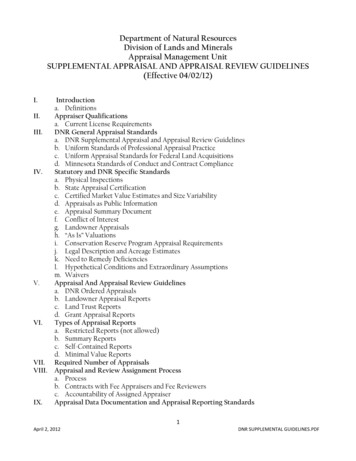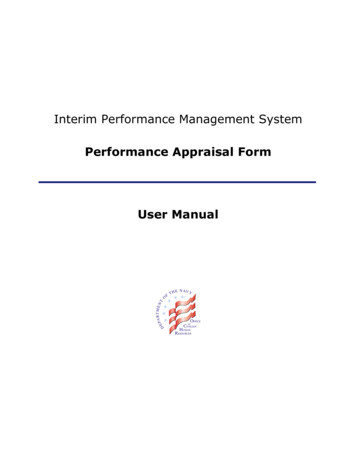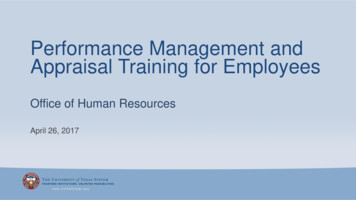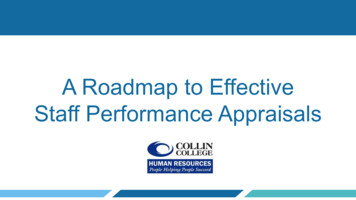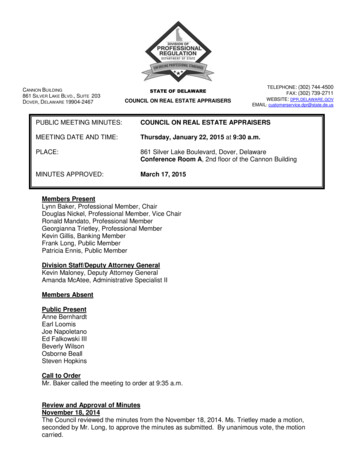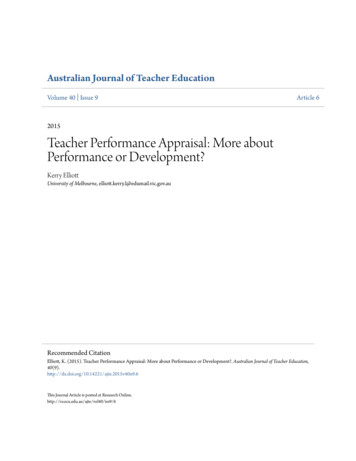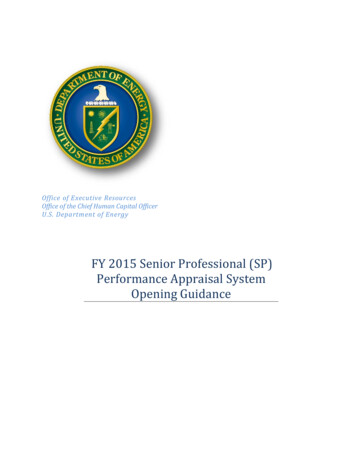
Transcription
Performance Management andAppraisal Training for ManagersOffice of Human ResourcesApril 21, 2017
Training Objectives Identify the benefits of performancemanagement Prepare you to conduct effectiveperformance conversations with your staff Be familiar with the performance appraisalframework and timelines Introduce future Performance Managementenhancement initiatives2
What is Performance Management?By definition, performance management is an ongoingprocess of communication between a supervisor and anemployee that occurs throughout the year, in support ofaccomplishing the strategic objectives of theorganization.How does that impact your business objectives?3
How Performance Management Makes aBusiness ImpactEnsures that employees’ work isfocused on the right areas to drive oursuccessReinforces a performance-based modelwhere exceptional performance is highlyrewarded and best performers areidentifiedEffective PerformanceManagementFosters employee engagementMaximizes work efficiency4
What is a Performance Appraisal?By definition, a performance appraisal is a formal recordof a supervisor’s assessment of the quality of anemployee’s work performance.How does that impact your employee engagement?5
When done well, a performance appraisal Emphasizes the value of an employee’s contributionsIs balanced, objective, and informativeSupports performance expectations by providingspecific and meaningful feedbackEngages the manager and employee in developinggoals and a career planCreates an environment for collaboration and opencommunicationContributes to employee satisfaction and inevitably thefuture success of the organization6
UT System Administration Appraisal FrameworkSelfappraisalby May10thTo better align our performance management andbudget processes, we are moving our appraisalcompletion deadline up to May 26th.AppraisalReviewComplete by:May 26thManagerappraisalApplies to: Benefits eligible Classified andA&P employees with a startdate* prior to 3/1 (merit eligible) Appraisal review period: June1, 2016 to May 31, 2017*Employees with a start date 3/2 or later will complete a 90 or 180-day appraisal (not merit eligible)7
Appraisal System: PerformancePro8
Performance Factors: Supervisor/Senior StaffPerformance FactorWeightAccomplishments: Work Plan, Goals, Duties and Responsibilities/ OtherAccomplishments40%Accountability: Focus on Results Quality Reliability Compliance20%Knowledge, Skills, and Abilities Communication Job Knowledge Teamwork20%Management Initiative & Innovation Planning & Resource Stewardship Leadership Identify, Hire, Develop, & Retain20%9
Performance Factors: Non-SupervisorPerformance FactorWeightAccomplishments: Work Plan, Goals, Duties and Responsibilities/ OtherAccomplishments40%Accountability: Quality Reliability Compliance20%Knowledge, Skills, and Abilities Communication Job Knowledge Teamwork20%Commitment to Excellence Initiative & Innovation Customer Service Mission Support20%10
Rating ScaleUT System uses a five-point rating scale Outstanding Performance Very Good Performance Meets job expectations and requirements and may occasionally exceed performance objectives.Needs Improvement Exceeded the expectations and requirements of the assigned position and regularly produces expectedaccomplishments in all areas of responsibility.Good Performance Exemplary accomplishments throughout the rating period and/or represented by unique and unusualaccomplishments and result in specifically identifiable or quantifiable benefit to System Administration or theinstitutions.May meet some of the job expectations but does not fully meet the remainder.Unsatisfactory Performance Fails to meet defined expectations and minimum job requirements.11
Writing the Performance AppraisalDo:- Use specific and relevantexamples- Be factual and objective- Clearly convey the intent of themessage- Balance review of the previousyear with forward-lookingcommentsDon’t:- Generalize- Avoid performance concerns- Use absolute words such as“always, never, completely, etc.”- Commit in writing what you cannot deliver12
Tips: Appraisals for Employees Rated “NeedsImprovement” Identify reasons for low performanceAddress specific areas needed for improvement and reinforce positive behaviorsConsider whether a counseling or action plan was implemented during theperformance periodPartner with HR Business Partner“1st, 2nd, and 3rd quarter financial reports were submitted late with errors causing delayedreconciliations. Recommend John Doe cross-reference data prior to submittal. Accuratereports are expected by designated due dates without errors/omissions.”13
Tips: Appraisals for Employees Rated “Very Good orGood” Emphasize areas where employee is succeeding and value theaccomplishmentsIdentify specific areas for developmentFind ways to motivate the employee to “raise the bar”“Jane Doe responds to employee inquiries within a timely manner. In responding, sheexplains processes and justifies responses. She researches information if needed prior toresponding to inquiries, In preparing tasks, events, meetings, trainings, comprehensiveplanning is always integrated (i.e., preparing materials, back up plans) Our focus is alwaysto maintain quality in services provided.”14
Tips: Appraisals for Employees Rated “Outstanding” Don’t gloss over specific accomplishmentsIdentify key competency areas that with some further development couldresult in significant gainsLearn what differentiates the strong performer from othersChallenge the employee to identify different or higher level assignments“Henry Smith consistently anticipates problems before they occur. Provides meaningfulinformation to decision makers that helps in the preparation and implementation ofprojects. Plans projects and carries them out so that projects are completed ahead ofschedule and under budget."15
Goal EvaluationThis step is only applicable if goals were entered in 2016. Evaluate current goals during this appraisal process. As an enhancement to the Performance Management process, HR will be holding leadership goal sessions tomove to a focus on performance goal outcomes. Once organizational and departmental goals are established, they will be communicated to all employees througha Goal Setting Process.As a result, no future goals will be added during the June appraisal process.Future goals will be created and documented in the upcoming months.16
Discussion and Feedback Meeting Schedule in advance, meet in private, and be on timeSet a positive tone, build rapport with a friendly welcomeActively listenAllow ample time for the discussionOutline the agenda for the meetingDuring a difficult message, stick to “Just the Facts”:– Follow the order of the evaluation document– Allow the employee to make a case, and if they have ampleevidence, consider adjusting the reviewIf the situation becomes escalated or emotional, stop the meeting andresume the next day17
Appraisal Feedback Scenarios
Clip 1: The team member’s perception of herperformance is very different than the manager’s. Listen to themanager’s initialresponse.
Clip 2: The team member starts to tear up andis very anxious. Listen to themanager’s initialresponse.
Clip 3: The manager is talking with a highperformer who is satisfied in her current role. Listen to themanager’s initialresponse.
Clip 4: The manager is addressing poorperformance. Listen to themanager’scomment.
PerformancePro Appraisal Quick OverviewBegin the process by:–––Logging into PerformancePro Using SNACSet to Appraiser RoleSelect EmployeeEvaluation Steps–––Evaluate FactorsEvaluate Current Assigned Goals (applicable only if goals were previously created in 2016)Complete Summary Comments (Summarize the Evaluation Period)4 Routing Steps to Complete/E-Sign––––Mark Ready: Indicates you are done with your first draft.Merge: This will combine both Employee Self-Appraisal and Managers Appraisal.Complete: Finalize the review and commit to historyE-Sign: Both Employee and Appraiser will E-Sign the Appraisal.23
PerformancePro1.2.3.4.5.Access UT4U http://www.utsystem.edu/ut4u/homepage.htmNavigate to Resources/Current Employees/Performance ManagementSelect the University of Texas System Administration as your home institutionEnter your SNAC login and passwordPress Submit24
Step 1: Evaluate FactorsFrom the Main Menu, under Appraisal, click Evaluate Factors. Select your role as an appraiser.Select the name of the employee you would like to appraise from the list box. Select a factor toevaluate from the Overview tab.12325
Step 1: Evaluate Factors (continued)Select a factor to evaluateunder the Evaluation tab.Next, select a rating for thefactor. Enter comments.114Repeat this step for eachfactor.22You can move through thefactors by clicking NextOR the Drop Down Menu3326
Step 2: Evaluate Current Goals (if applicable)From the Main Menu, under Appraisals,click Evaluate Goals. Next, select a ratingfor the goal. Enter comments. Repeat thisstep for each goal.32441527
Step 2: Evaluate Goals – Comment CoachingDon’t quite have the words?Appraisers may utilize a list oftemplate comments that can beadded into the comment sectionof the Goal you are evaluating.Choose from “Areas of Strength”to “Areas of Improvement”.28
Step 2: Evaluate Goals (continued)This is the view prior to evaluating on the overview tabThis is the view after goal has been evaluated.29
Step 3: Summary CommentsFrom the Main Menu, under Appraisals, click Summary Comments. Click in the Summary Commentsbox and enter any additional information, concerns, etc. (if desired). Enter information in the additionalcomment fields.30
Routing Process Step 1 - Ready for MeetingOnce completed, markthe appraisal Ready forMeeting.Once the Employeehas completed theirself-appraisal theAppraiser will receivean automated email.31
Routing Process Step 2 - Merge Appraisals Click on MergeTo allow the employee access totheir merged appraisal, click theAllow Employee Access checkbox.221132
Routing Process Step 3 - Complete AppraisalWARNING:THIS IS YOUR LASTCHANCE TO MAKECHANGES.Once you mark “Complete,”the action will generate ane-mail notification to boththe employee and appraiserfor E-signature.33
Routing Process Step 4 - E-Sign Appraisal213YOU HAVE COMPLETED THE APPRAISAL PROCESS!34
Employee E-Signs AppraisalThe employee’s E-Sign screen will look a bit different. They will have the option toagree/disagree with the appraisal, add a comment and then E-Sign.35
Step 1: Review NotesStep 6:Sign the AppraisalStep 2:EvaluateFactorsStep 3:EvaluateGoalsStep 4:Ready forMeetingMeetingStep 2:EvaluateFactorsStep 3:EvaluateGoalsStep 4:Ready forMeetingStep 5:MergeAppraisalStep 7:Complete theAppraisalEdit Appraisal, ifnecessaryAppraiserEmployee Self AppraisalBy May 26thStep 1: Review NotesStep 8:Sign the Appraisal36
We heard you, and we’re making changes toimprove the Performance Management process. Transition from performance factors to Leadership CompetenciesReplacing Performance Appraisals with a new Performance Goal processSimplified weighting systemA focus on performance goal outcomes, not activitiesFeedback from peers and/or indirect managersOngoing performance discussions and teachable momentsIntroduce Pay for PerformanceSystems enhancements coming 37
Resources UT System UT4U Performance Management Site– Leader Toolkit to include: FAQsPowerPoint SlidesQuickstart GuideFactor Weight and Definition GuideOHR SharePoint– Recorded Presentations (Video/Audio) HR Business Partner38
HR Business Partner TeamSiria Barrera, MA, SHRM-SCPHR Business PartnerJulio Arizmendi, MPAHR Business PartnerDEPARTMENTSBOARD OF REGENTSFEDERAL RELATIONSGOVERNMENTAL RELATIONSHEALTH AFFAIRSHUBHUMAN RESOURCESINNOVATION & STRATEGICINVESTMENTOGCPOLICE (ODOP)SHARED SERVICESSTRATEGIC INITIATIVESTMD-SASDEPARTMENTSBUSINESS AFFAIRSBUSINESS DEVELOPMENTCONTRACTS AND PROCUREMENTCONTROLLER'S OFFICEEMPLOYEE BENEFITS (OEB)FINANCEOTISINFORMATION SECURITYRISK MANAGEMENT (ORM)SHARED BUSINESS OPS (SBO)SYS-WIDE INFO SVCS (SWIS)SYSTEMWIDE COMPLIANCETOGIDEPARTMENTSACADEMIC AFFAIRSCHANCELLOR'S OFFICEEXTERNAL RELATIONSJohnny Reyes, SHRM-SCPHR Business PartnerFACILITIES (OFM)OFPCDEPARTMENTSAUDITINST FOR TRANS LEARN(ITL)SHARED INFORMATIONSERVICES (SIS)Stephanie Gil, PHR, SHRM-CPManager, HRBP TeamUNIVERSITY LANDS39
40
rewarded and best performers are identified. Fosters employee engagement. Maximizes work efficiency. Effective Performance Management. What is a Performance Appraisal? By definition, a performance appraisal is a formal record of a supervisor's assessment of the quality of an employee's work
